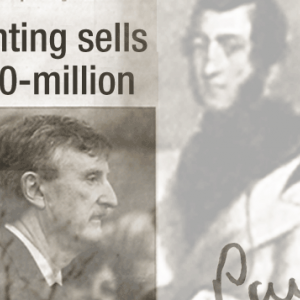"The Art of the Deal"
By Gabrielle Giroday
The Winnipeg Free Press
July 31, 2005
Leaning back in his leather-chaired office tucked away in his gallery on St. Mary's Road, the modestly suited David Loch looks more like an insurance broker than the man who bought Paul Kane's Scene from the Northwest for Lord Thomson for $5.0 million in 2002, the highest amount ever paid for a Canadian painting.
This May, during the high-end spring auction season, he gained national attention for record-setting bids of more than $550,000 for an oil sketch of Mount Robson by Lawren Harris and $388,300 for the same artist's sketch of Clyde Inlet, Baffin Island.
He also represents two of Winnipeg's best-known artists, Ivan Eyre and Leo Mol.
Then there's the man's love of Pooh.
Loch is locally famed for spearheading the city's purchase of a $285,000 E.H. Shepard painting of Pooh at a Sotheby's auction in London in 2000, as well as a $100,000 A.A. Milne-inscribed copy of Now We Are Six in 2002. He's also been lobbying, along with the volunteer group Partners in the Park, to obtain a space in Assiniboine Park devoted to all things Winnie.
Five years later, the future of the so-called Poohseum is still up in the air after possible backers like Disney vanished. But Loch is a patient man, and he's confident the Winnie museum will eventually happen.
"I'm very comfortable in what I do. I've got a job to do for clients and I want to do it well, so I just go ahead and get it done," Loch says in a lilting brogue that betrays the Scottish roots of a man who emigrated to Winnipeg more than three decades ago with just $90 in his pocket.
Loch travels differently now, with a little more in tow. But although the value of the goods he carries has increased steeply over the years, to other airline passengers Loch looks like just another traveller.
"I often have (paintings) in my lap, or just up (in the overhead baggage compartment)," he said. "People have no idea."
Loch says the art of the deal depends on cultivating the comfort level of the potential collector and playing it cool when it comes to purchasing. Hence, he's honed a technique that doesn't encourage a one-time art shopping spree, but rather an acquisition over time of pieces that culminate in a carefully assembled collection.
Loch also makes a point of educating potential clients on what they're getting into.
"It takes two and a half hours for me to give a sort-of brief overview of what I believe in the art world," he says, adding he's had to dissuade some very wealthy and powerful clients eager to purchase art from immediately laying down their money.
In an industry where trust between art collector and dealer is critical, word-of-mouth endorsements are key. Ken Thomson, for example, approached Loch in the early 1980s after hearing positive buzz about him from another client.
In the decades since, while representing a few deep-pocketed clients—Thomson's net worth has been estimated at $21 billion—Loch has set records at auctions across the country while racking up additional millions in private sales.
In the art world, paintings can be traded from buyer to buyer by private word-of-mouth through dealers, or, they can be put up for sale at auction, a public war where biggest wallet wins.
For most dealers, private sales make up the majority of their business, but a few very public big-money bids at auctions can get people gabbing.
"Success breeds success," Loch says. "Where you compete is at auctions. But as far as private acquisitions... it depends who gets the referral into the collection to see the painting that is coming up for sale."
Loch's success at auctions has earned him the respect, and envy, of other art dealers.
"I'm always the bridesmaid," said Miriam Shiell, another prominent dealer, to a Toronto newspaper after Loch edged her in a string of consecutive auctions. "David comes in and chops people's heads off," she said.
Others, like Hugh Hildesley, the English-accented executive vice-president of Sotheby's New York office, have a more delicate way of putting it. Hildesley, who acts as an auctioneer in the Canadian art battles, says Loch showcases a subtle strategy as he lays claim to the "lot," or artwork, on the block.
"He lets people haggle for the lot until right at the end, and then up comes the paddle," Hildesley says. "He would come in typically when there are only two bidders left, and the bidder who is least confident about going on will drop out when a new bidder comes in."
At the same time, the other of the two bidders, who probably thought he or she was on the verge of getting the piece of art, will get discouraged because Loch's entry means the bidding will continue, says Hildesley.
"So it gives you a kind-of advantage over the person who thought they were going to be successful."
Loch's instincts for salesmanship were honed after he answered an Edinburgh newspaper ad looking for adventurers willing to sell Eaton's merchandise overseas, and soon after found himself stationed in Winnipeg.
After becoming a framer in his then-girlfriend's father's business, he opened a private venture in 1972 in a converted St. Vital grocery store—the locale where $32,000 art by Ivan Eyre now hangs on the wall, and some of Leo Mol's sculptures grace the pebbled front garden.
To drum up business, Loch placed small ads in newspapers across the country, staying in hotel rooms while waiting for potential clients to show up with their treasures, like an obscure Group of Seven sketch bequeathed in a great-aunt's estate.
Now, they come to him unbidden. During an interview, he plucks a copy of Robert Munsch's 22-million-selling children's classic Love You Forever off his desk and mentions how the illustrator recently contacted him about potentially selling the work after storing the original paintings under her bed for 19 years.
"He's a very astute dealer... probably number one, or top two or three, in the secondary art market," says industry watcher Anthony L. Westridge of Loch's canny acquisition of "already-owned" or "resale" art. Westridge compiles the most detailed reports on art markets across the country, the Canadian Art Sales Index.
"As a result of that client [Thomson] specifically, he's a very high-profile dealer, because he likes to be seen to be buying pieces," Westbridge says.
Loch's not the only one on a hot streak. Westbridge notes that sales of Canadian art this year are approaching $40 million, a 20 per cent jump from the previous year. The market for Canadian historical art, in particular, has been heating up. Record prices are being paid for historical landscapes, with the tried-and-true Group of Seven paintings often leading the pack.
Loch says Canadian tastes lean to the "traditional," with interest for abstract art among buyers notably muted compared to their appetite for anything with trees, rivers or canoes.
Like any business, the art market is prone to its own booms and busts. For the last decade, Canada's big three auction houses, Heffel's, Joyner Waddington's and Sotheby's, have been racking up big sales, with front-and-centre dealers in the very public arena reaping the benefits.
With each new record bid, the buzz around the dealer who places it increases. That publicity can be almost as valuable as the art, never mind the reported five per cent commission dealers make for closing a major sale, according to Westbridge.
"If you got it, milk it," Westbridge says. "You can be sure people in the room or reading the paper would look at it and say, 'Oh, I've got a painting like that, I'll call Mr. Loch.' So for him it's a great source of publicity, and I'm sure he gets offered a lot of great paintings as a result of people knowing he's the buyer of a bigger piece."
Loch runs his gallery in Winnipeg with the help of his wife, Alison, and sons Ian, 25 and Graeme, 18. A third son, Alan, 28, is in charge of Loch's two-year-old operation in Toronto, the former Nancy Poole Studio, located in chi-chi Yorkville.
Loch says the auction market can falsely inflate the true value of a piece of art, and that's why clients need a dealer to help them navigate the waters so they're not "lambs led to slaughter."
"There's nothing wrong with the hype at the high end, the great end, but there's lots wrong with the hype at the end where the paintings are weak," he says. Loch believes, for example, that the craze for Group of Seven pieces has led to some of the late A.Y. Jackson's work being overvalued.
"What worries me when I see late A.Y. Jacksons going for $25,000, things he painted very late in his life... if that level is true, then this is where buying the right period Jackson makes that much more sense," he says. "That means the lovely little early panels he did should be selling for $200,000, which they're not. They're selling for $50,000 to $60,000."



